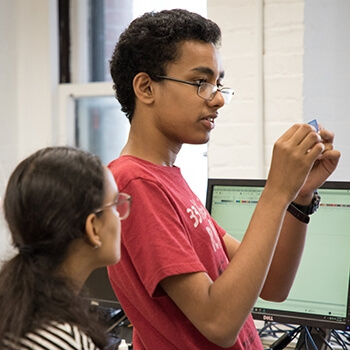News
Students develop solar cells during cross-cultural, hands-on program
The Renewable Energy Harvesting and Storing Program, run by the Active Learning Labs at the Harvard John A. Paulson School of Engineering and Applied Sciences (SEAS), explores the theory and fabrication of solar cells and batteries.
Between June 24 and July 3, students from Harvard and the Ulsan National Institute of Science and Technology (UNIST) in South Korea learned about basic semiconductor physics and crystalline silicon solar cells.
Students from Harvard and Ulsan National Institute of Science and Technology in South Korea collaborated to design and fabricate solar cells. (Photo by Molly Carlough)
Solar cells, also known as photovoltaic cells, convert the sun’s energy into electricity. This works through a process known as the photoelectric effect: when photons that radiate from the sun hit the silicon atoms of the solar cells, they transfer their energy to loose electrons, knocking them off the atoms. Once other elements are added to the tightly structured silicon atoms, it creates n- and p-type silicon atoms that become positively and negatively charged, creating an electric field. In silicon’s role as a semiconductor, the cell maintains this imbalance and is able to drive loose electrons in a single direction, creating an electric current.
Solar cells are one of the many technologies being used as a source of renewable energy, providing sustainable power that is both durable and long-lasting. They are seen as one possible way to reduce global warming. Besides being used in satellites, water treatment, and emergency power supplies, they are also used in many common products such as toys, watches, and calculators.
The collaborative UNIST program combined lectures and discussion with hands-on applications. Rather than merely discussing topics such as the light absorption of silicon or effective carrier collection, students were able to design, build, and test their own cells and turn concepts into physical creations.
A rising sophomore at Harvard, Tyler Sanok was surprised by the hands-on nature of the program. He and his peers jumped right into the labs and did much more work than he had expected.
Students apply the concepts they learned to design and fabricate solar cells in the Active Learning Labs. (Photo by Colleen Anderson)
Building off the concepts they learned, the students’ goal was to create the most efficient solar cell possible. They developed their cells through a four-step process: surface texturing, doping, printing electrons, and anti-reflection coating.
By the end of two weeks, three groups, each consisting of students from both universities, had created and tested their solar cells. They presented their findings to faculty and students.
One of the unique aspects of this program is the opportunity for students to interact with those from other universities.
“I was really interested in the collaborative component of the program,” said engineering sciences concentrator Shreeya Panigrahi, A.B. ’19. “The fact that it was Harvard and UNIST collaborating, I thought it was a really cool opportunity to work with other students and get a sense of how research and other coursework and assignments would be in other universities.”
Ye Rim Seo, a junior at UNIST, described how having this experience at Harvard was very enlightening because the students had a chance to discuss and explore various concepts in depth, as opposed to only being presented with an article or lecture on a topic.
The students are now completing the secondary portion at UNIST in Ulsan, South Korea. There, they will learn the processes of battery fabrication, specifically studying Lithium-ion and seawater batteries as a means to store the energy created by their solar cells.
Students fabricated solar cells using a four-step process: surface texturing, doping, printing electrons, and anti-reflection coating. (Photo by Colleen Anderson)
Topics: Geoengineering
Cutting-edge science delivered direct to your inbox.
Join the Harvard SEAS mailing list.


